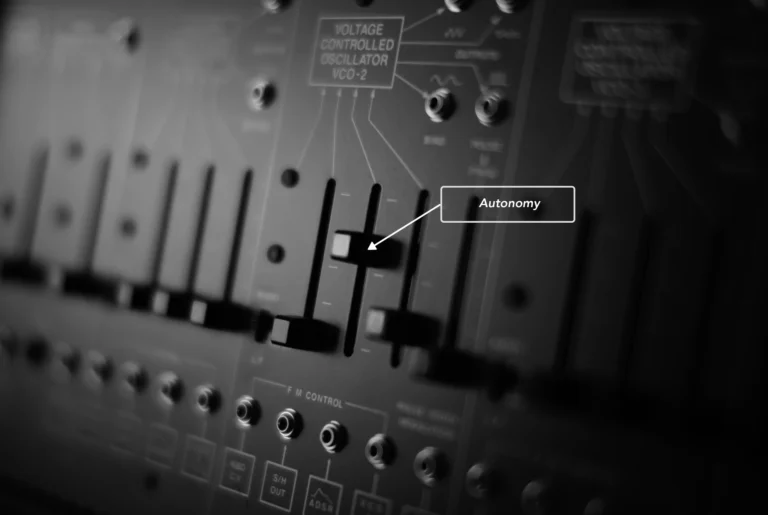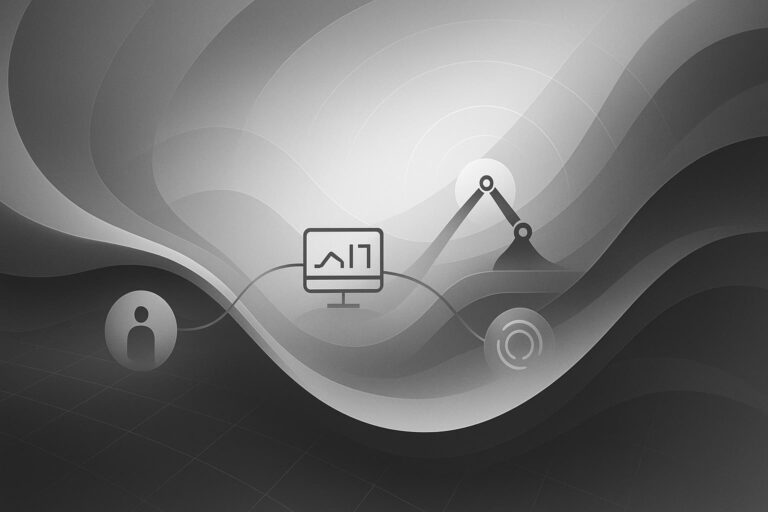What is robot operations?
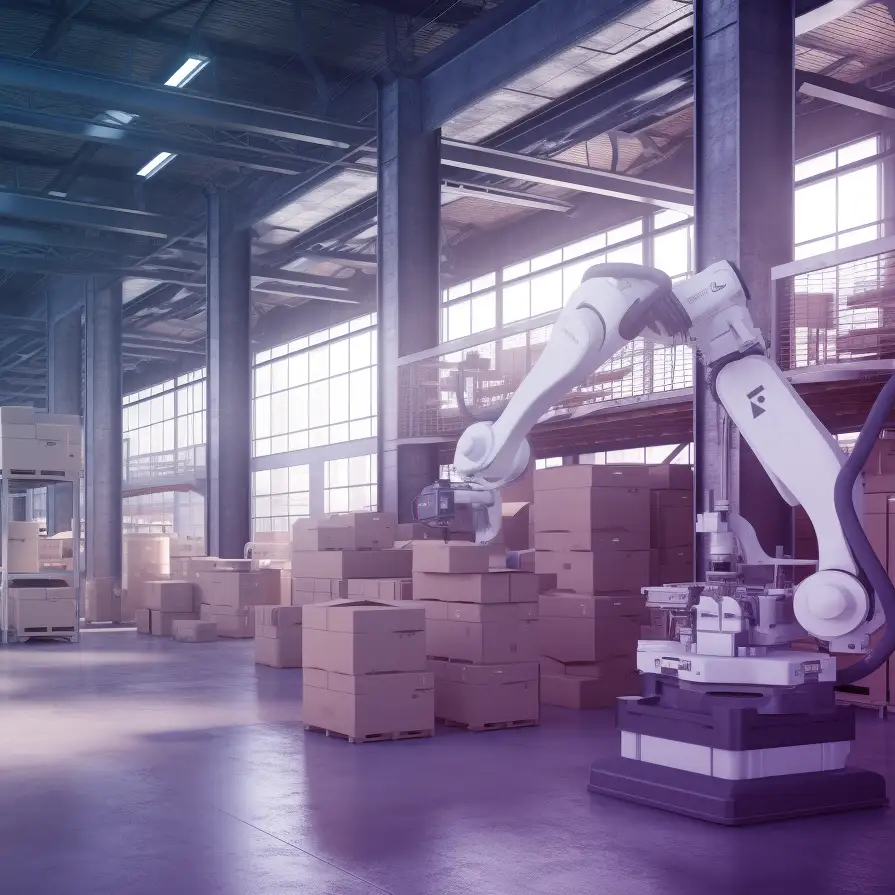
Robotics has evolved beyond simply “can it be done?” to the more business-driven question of “how can we do it better, faster, and cheaper at scale?”
Initially, robots were primarily used in industrial settings, such as the floor of an auto manufacturing plant. Fixed in place, they often performed a very limited set of commands on pieces moving through the plant floor.
Next came autonomous guided vehicles (AVGs) that moved along a fixed track, followed by robots freed from fixed pathways, called autonomous mobile robots (AMRs). Today, a single warehouse or healthcare facility may deploy many different types of robots.
Now that we have answered, “Can it be done?” that leaves the question, “How can we do it better, faster, and cheaper, at scale?” as the puzzle to solve. Enter robot operations.
On this page, we’ll explore the drivers and enablers of robot operations along with the keys to successful implementation. We’ll also touch on how Formant’s offerings help users deliver on the promise of using robot operations to efficiently scale up.
Table of contents
What is robot operations?
We define robot operations as the practice of observing, controlling, and performing analytics on active robotic devices. Robot operations guides operators on how to best manage their deployment.
Gone are the days of a handful of the exact same robots being piloted on a limited scale. Many of today’s robot fleets are large, heterogeneous, and complex to manage. Robot operations is the function that must be optimized to realize the promised return on investment in robotics.
Robot operations market drivers
Focus on efficiency and cost
Labor shortages
According to the U.S. Chamber of Commerce, as of October 2022, there were about 10 million job openings and only six million unemployed workers. While the Chamber cites many causes for this gap, the end result is that workers have choices. Given other options, they’re less likely to take a job that is dull, dirty, or dangerous. Robots are well suited to these roles as they don’t get bored, afraid, or need to scrub away the worries of the day.
Explore our data ops platform
Robots are well suited to these roles as they don’t get bored, afraid, or need to scrub away the worries of the day.
Robots are no longer pilot programs
Many companies dabble in robots while exploring ways to increase operational efficiency and lower costs. Initially, however, there’s an expected learning curve and management doesn’t expect a pilot program to deliver cost savings.
As those pilot programs evolve into production-level installations, the focus on efficiency and cost savings increases. All the little inefficiencies of running a fleet grow exponentially until there’s a significant obstacle to scale. Strong robot operations is required to enable the journey from a handful of robots to a fleet.
Rise of Robots-as-a-Service
Open a search engine, type in “as a service,” and you’ll be inundated with offerings that can be purchased as a service. This business model is especially attractive when the product has a high acquisition cost and requires some expertise and ongoing investment to maintain.
In the case of robots-as-a-service, a customer may not possess sufficient expertise or capital to finance and operate robots themselves, opting instead to pay a service provider for the their robotic needs. These customers pay for their robot solution out of their operating expense budget rather than their capital budget, which aligns with the operating costs those robots reduce. The RaaS provider takes on the capital expense of building the robots and provides the support and expertise for successful deployments.
This symbiotic relationship requires solutions that empower customers to manager their deployments while RaaS providers need visibility across their entire customer base.
Grown-up heterogeneous fleets, grown-up requirements
Bigger is only better in robot fleets if you can comfortably manage them. In addition to the challenges of managing a large fleet, a maturing installation must be able to meet corporate standards around security and compliance, rules around use of the cloud, support identity management and single-sign-on capabilities and align to data governance and storage policies.
Grown-up fleets are typically comprised of multiple types of robots that all must be managed in concert. Robot operators need a holistic view of the entire deployment to operate efficiently instead of flipping back and forth between robot- or vendor-specific tools.
Managers of robot installations also must be able to report on key metrics over time to assess whether the fleet is delivering on corporate expectations of efficiency and cost avoidance.

Robot operations market enablers
Connectivity
As discussed earlier, most of the first robots in the industrial space were fixed in place. But innovators sought to liberate robots so they could move to the work, rather than the work coming to the robot.
That requires a way to communicate with them while they’re on the move, without wires and cables. Advancements in wireless technology, both in terms of local networks as well as tapping into public infrastructure, have enabled robots to send data back to operators to facilitate remote operation and monitoring.
Real-time transmission of high-resolution video and photos
High-quality cameras capturing high-resolution images that are sent back to the robot operator are critical must-haves for many robots. Not only are the images and video collection sometimes a core deliverable for the robotics use case, without this visibility, operators are essentially flying blind and reliant solely on other transmitted data to determine what has occurred or is being observed.
Price drops for camera lenses and the wireless data transmission technology have sparked new applications and wider usage of this capability.
Sensors
Humans possess five senses and we use them to navigate the world around us and make sense of what we encounter. A robot, however, needs a variety of sensors to collect information about its environments.
Robot sensors allow robots to take in information from the world. To gather data about its surroundings, robots employ different combinations of light sensors, proximity sensors, sound sensors, tactile sensors, temperature sensors and accelerometers. These augment the navigation and positioning sensors robots need to get to the right location to perform their tasks.
Specialized robotic use cases may employ other sensors to detect humidity, the presence of certain gasses or magnetic fields. The range and breadth of sensors and their increasingly lower price points are fueling the fervor for robots.
Cloud computing and storage
Connectivity makes it possible for data to flow back to operators, but that large volume of information demands significant processing power and storage. By transferring not just the data, but the computing power itself to the cloud, roboticists can develop lighter, cheaper robots and put the robot’s more expensive “brains” in the cloud.
Cloud robotics allows for teleoperation of robots (operating a robot from a distance) and a place to analyze and store the vast amounts of data robots generate. By housing the computing power of each robot in the cloud, the cloud becomes smarter, and operators can focus on managing the cloud, rather than individual robots—all vital to scaling up.
Cloud robotics permits the pooling of learnings and analytics from multiple robots across multiple locations, setting the stage for data-hungry artificial intelligence and machine learning applications.
Standards and APIs
In a maturing heterogenous environment, a robot manager has multiple robots from different vendors all deployed at the same time. While most vendors provide their own modules to control and manage their flavor of robot, in a heterogeneous environment the lack of continuity and compatibility means a hectic, disjointed experience for operators and lots of manual exporting and manipulation of data to look across all their robots.
This is where standards and APIs come in. Industry standards enable an operator to send those vendor-specific data streams to a centralized platform so all the information can be visualized and viewed holistically. Three of these are particularly prevalent in robot operations today:
- The Robot Operating System (ROS) is an open-source standard robotics middleware suite somewhat based on Unix.
- The unified robotics description format (URDF) is an XML file type standard that describes the physical specs of each robot and what it can do. UDRF lets an operator manage different robot types in a central hub.
- A standard messaging protocol, controller area network (CAN), enables an operator to pull raw data from robots so robot managers and other applications can communicate with the robot. APIs enable proprietary robotic applications to be connected to a central platform, so that data and operations can be more integrated, weaving together proprietary and open source applications.
Automation, AI, ML
All of the enablers we’ve covered so far are the technology must-haves to successfully operate a heterogeneous fleet of robots. This last set of enablers is the newer wrinkle with the potential to make efficient robot management a key differentiator.
Automation, artificial intelligence (AI) and machine learning (ML) all offer the potential to automate or educate away some of the reliance on humans for management tasks. Automation allows operators to link together a command or series of commands when a specific set of criteria have been reached. Automation also facilitates the application of a set of commands to a single robot, all the robots of the same type, or the robots in a specific location.
As data is centralized and structured in a single platform, there is now the critical mass of data points needed to train AI and ML in a robotics environment. By ingesting data about the organizations robots, performance, applications and behavior over time, AI and ML can recognize patterns and learn to respond to obstacles and situations with less and less human support.
Offloading these tasks to technology lets the human operator deal with the much smaller number of edge cases where human know-how is needed, enabling a single operator to effectively manage multiple robots.
Formant For Robot Operations
Formant is a data platform for robotics companies that enables organizations to optimize and scale robot operations. This includes support for all the key enablers discussed above.
With Formant, users have the ability to connect to, teleoperate, monitor, diagnose, manage, and analyze robots and their associated data. By bringing all these capabilities into a single, vendor-agnostic platform, we empower robot operators to manage large, heterogeneous fleets of robots while keeping the ratio of humans to robots at a cost-controlled level.
Key robot operations functions supported by our platform include:
Connect
Step one is to ensure your robots can connect with your central platform. Challenges include issues around the amount of data that can be transmitted at once (bandwidth), the lag between sending and receiving (latency), and gaps in wireless network coverage. To make sure your network is up to snuff, we recommend network constrained testing, when deploying a network for robots.
The introduction of 5G wireless infrastructure offered better speeds and connectivity good enough to avoid problematic WiFi handoffs in exchange for a relatively simple modem or hotspot swap. Formant includes a suite of tools to make it easy to connect to your devices, including supporting secure shell (SSH) protocol to enable remote control over the internet via port forwarding without the need to run a virtual private network (VPN).
Formant also offers an on-premises option for customers such as nuclear facilities, which are required to be air-gapped, or in healthcare settings with restrictions on HIPPA data storage and usage.
Teleoperate
Robots-as-a-service companies are keen to avoid physically travelling to a stuck or ailing robot to diagnose and resolve problems. A key step to understanding an issue is visualizing it, which is why teleoperation is so important. Teleoperation is the operation of a system or machine at a distance, sometimes known as remote control.
Teleoperation is an important capability when a robot can’t return to an autonomous state, but it can also be a key element of the solution itself. Organizations may use teleoperated robots for tasks that are dangerous, such as bomb disposal robots, or located in rugged terrain or an inhospitable environment, such as undersea pipeline monitoring. The ability for the robot to both visualize the situation and also receive and execute commands sent from afar is integral to the solution’s value.
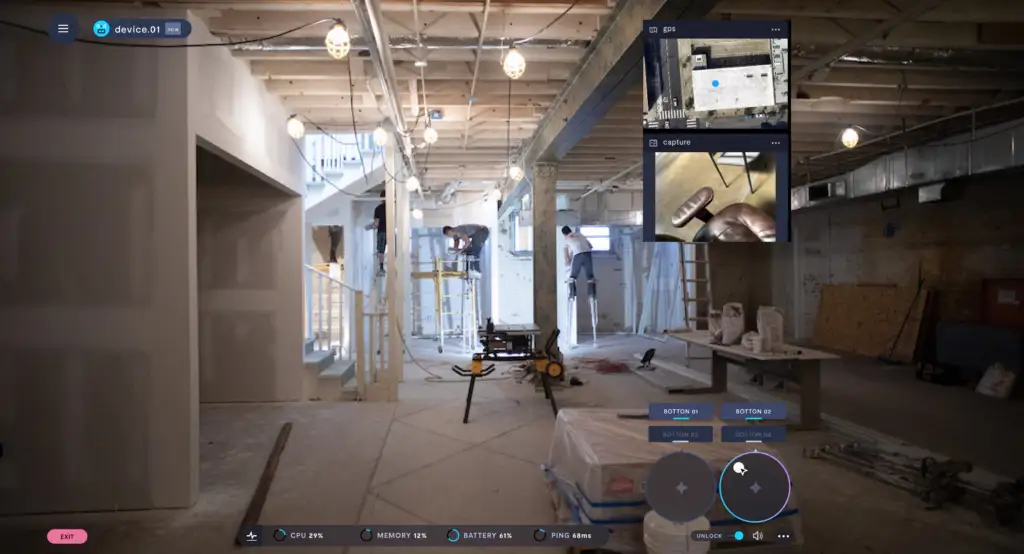
Formant’s teleoperation capabilities include:
- Realtime, low-latency connection
- Support for audio and video live streaming
- Map-based navigation
- Secure network access without a VPNG
Monitor and Diagnose
Spend even a brief time in any operational role and there’s no doubting the value of proactive monitoring to discover potential issues before a problem appears. The Formant solution allows users to monitor, diagnose, and resolve many of those issues and native support for ROS and ROS services ensures speedier communication.
There are two main components for robot monitoring: data visualization and eventing workflows. For data visualization, it is important that you are able to collect the right data, visualize it in a meaningful way, and recognize when anomalies appear.
Formant supports out-of-the-box data visualization for:
- Battery status
- CPU load
- Memory usage
- Locationalization
- Telemetry
- Commands
Formant’s proactive monitoring features also let you set up alerts and notifications for critical leading indicators of impending trouble. Automation and scripting features enable operators to automatically trigger one or more actions in response to any event. Certain notifications can be pre-set to directly alert the right person to resolve the issue, or to a Slack channel or PagerDuty.
For those times when a problem occurs and a diagnosis is necessary, a robot technician will need to be able to view the current status of the robot, access the cameras, receive log files, push out commands and teleoperate. All these tasks can be performed from Formant’s platform, which also collects and organizes data from each support event for metadata tagging, easier searchability and ongoing tracking.
Manage
While “fleet management” can apply to trucks, taxis, scooters, buses and the like, in the world of robotics it refers to the ability to manage multiple robots of various types from a variety of vendors. Formant provides a single platform to cost-effectively scale up a fleet of robots or multiple fleets in disparate locations. Warehouses are a great example of this, as many roboticized warehouses have AMRs that deliver items, robots that pick items, robots that move large pallets, and robots that clean and inspect.
Getting locked into a specific vendor’s platform constrains companies’ ability to select best of breed robots for an evolving solution. A vendor-agnostic platform like Formant that supports MassRobotics interoperability standard or VDA 5050 provides the same level of detailed data about each robot, regardless of its make and model. And with multiple AMRs moving around on the floor, it’s important to ensure that robots of different flavors don’t collide when their paths intersect.
Teleoperation, connectivity, and data visualization are utilized to troubleshoot robots, but remote management goes beyond just fixing issues.Formant’s platform APIs enables you to integrate your robot operations data with productivity and workflow tools, applications, and databases. Support for Open-RMF (Open Robotic Middleware Framework) allows multiple fleets of robots to interoperate with each other and shared building infrastructure including doors, lifts, and corridors where bottlenecks can occur.
Fleets of all shapes and sizes also require periodic simultaneous remote application configuration changes across multiple robots at scale. Formant enables this through the Formant web app or a command line tool, allowing you to choose whether to apply changes on an individual robot or an entire fleet. The Formant agent resident on each robot is constantly checking if there are any new configuration settings, so your latest changes get implemented right away.
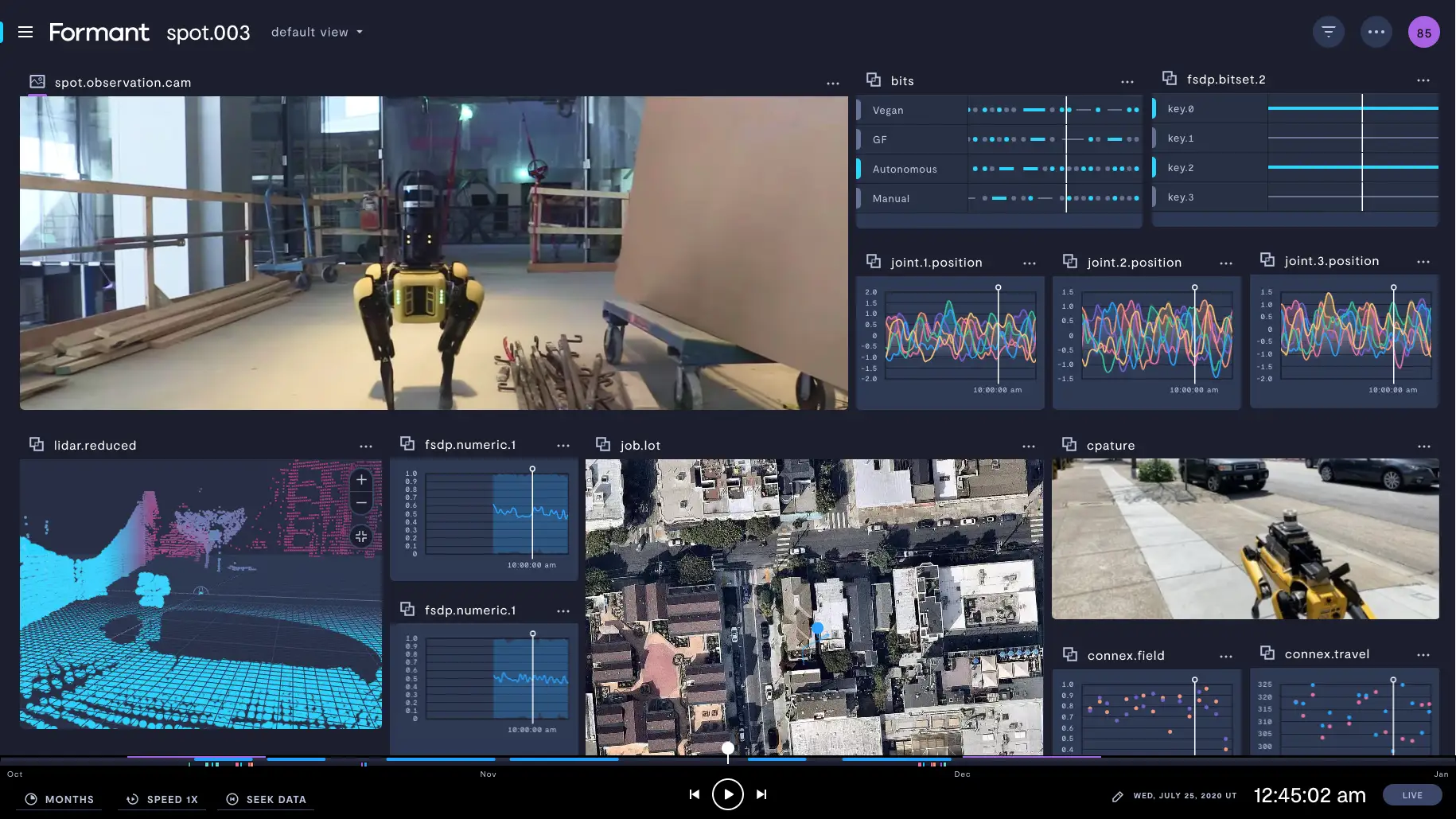
Analyze
While connecting, teleoperating, monitoring, diagnosing and managing a fleet or fleets of robots in Formant, you are also centralizing rich data about your robots and environment, making analytics possible. In scaling up robot operations, analytics takes you from the realm of possible to the land of cost efficiency.
Past and current data enable you to look at trends and deviations to gain insights that improve operations and lessen the need for hands-on human intervention. Formant’s platform brings together past and current state information to provide a richer environment that can support analytics tools, including artificial intelligence and machine learning technology. Analytics give robot operations teams the tools to visualize information, proactively avoid issues, increase robot autonomy and meet company goals and metrics for efficiency.
Data flexibility is also built into the Formant platform. You can easily pipe data from Formant into third party systems, such as Tableau or Jupyter Notebooks, for further analysis
Implementing Robot Operations
If you reached the point where you need to scale up your robot fleet, scale down your human operators, or both, robot operations may be your solution. Deciding to focus on robot operations is not enough, however; robot operations must be implemented effectively to deliver on its promises.
Five keys to implementing robot operations
Rolling out robot operations as a core competency across your organization is a significant initiative, but with a few tips, you can start reaping the rewards of your investment and optimizing your operations in no time.
- Start with the right people. People that operate or manage robots, and people that work around or interact with robots need robot literacy. Building robot literacy will help ensure that everyone has access to the rigtht training and resources for working with robots, and understands your organization’s robotics strategy and that you are on your way to developing the employees who will eventually carry out that strategy.
- Get your arms around data. Where is it? In a system? On the robot? In the cloud? To make the most of automation and AI, you need large amounts of data to train the tools. If your data environment is disorganized, it needs to be brought together and managed as the asset it is. And in the process, it is vital to understand any regulatory or legal requirements about data handling and ensure you are complying.
- Document your processes. We’ve moved into an era of documentation “lite.” This makes sense, given a focus on things that drive business. However, it is hard to have smooth running operations if there is not a shared understanding of how to carry out these tasks. The key is to prevent this documentation from being slapped in a binder and plopped on a shelf, never to be used again. Your documentation can and should be used to train new team members and ensure that everyone received the same information. It also ensures that when that one guy who is the only one who knows how to fix that one weird thing wins the lottery, someone else will be able to step into his shoes.
- Define a few key metrics . . . and track them religiously. A common metric used for this purpose is the ratio of robot carers to robots, as this essentially measures ability to scale. It is an easy metric for people in any department in the organization to understand and tracking it over time will tell the story for you. More granular metrics will likely be needed for the robot operations team, but make sure you have one or two top-line metrics that everyone can understand.
- Iterate. Whether you use agile or scrum or kanban or scrumban, the most important thing is that you are segmenting bite-sized chunks of operational inefficiency, testing out potential solutions, and then iterating until the solution meets the requirements. Iteration of segments of work frees operations organizations from the perceived need to “boil the ocean,” and helps ensure that the team can experience some early wins.
Formant’s robot platform addresses the critical operational functions needed to operate robots at scale, brings together data and applications to enable the use of automation, AI and machine learning to bring your robot operations to the next level.

